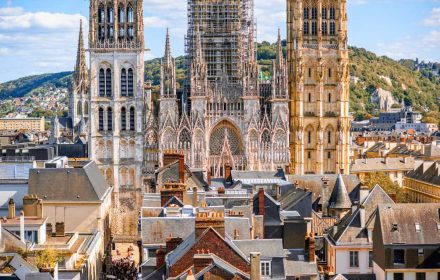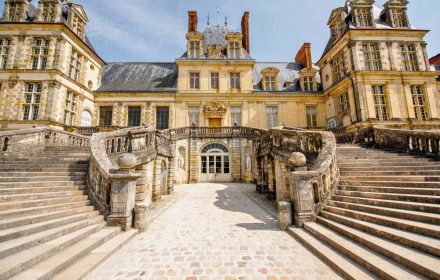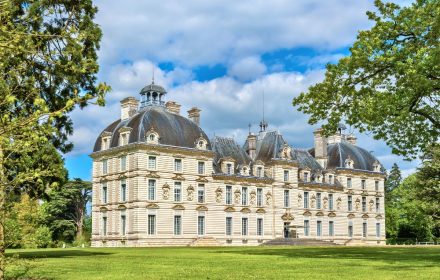This site uses affiliate links, meaning that if you make a purchase through our links, we may earn an affiliate commission.
Château de Chambord is the largest château in the Loire Valley, built by King François I as an over-the-top hunting lodge. It has 400+ rooms, a rooftop that looks like a mini city, and a double-helix staircase believed to be inspired by Leonardo da Vinci. The estate is so vast that it’s actually bigger than Paris!
Wondering what to see at Château de Chambord? From the grand interiors to the stunning terraces and gardens, here are the top spots you can’t miss—plus a few tips to make your visit even better.
- 1. Brief History of Château de Chambord
- 2. What to See at Château de Chambord
-
- 2.1. The Architecture of Château de Chambord
- 2.2. The Famous Double-Helix Staircase
- 2.3. The Roof Terrace and Chimneys of Château de Chambord
- 2.4. The Coach Room (Salle des Carrosses) - Ground Floor
- 2.5. The State Apartment (Appartement de Parade) - First Floor
- 2.6. François I’s Private Quarters and Oratory - First Floor
- 2.7. The Chapel (Sainte-Chapelle de Chambord) - First Floor
- 2.8. Vaulted Rooms with Ornate Ceilings - Second Floor
- 2.9. Maréchal de Saxe Theater - Second Floor
- 2.10. Exhibition on World War II Art Preservation - Second Floor
- 2.11. The Gardens of Chambord
- 3. Practical Tips for Visiting Château de Chambord
Brief History of Château de Chambord
Château de Chambord is a stunning blend of art, history, and royal ambition!
Built in 1519 by King François I, it was initially conceived as a hunting lodge but quickly became one of the most extravagant architectural projects of the Renaissance.
While no one is entirely sure who designed it, many believe that Leonardo da Vinci may have had some involvement, especially with the château’s iconic elements. The most famous feature? The double-helix staircase that allows two people to ascend and descend without ever crossing paths—an ingenious design that still fascinates visitors today.
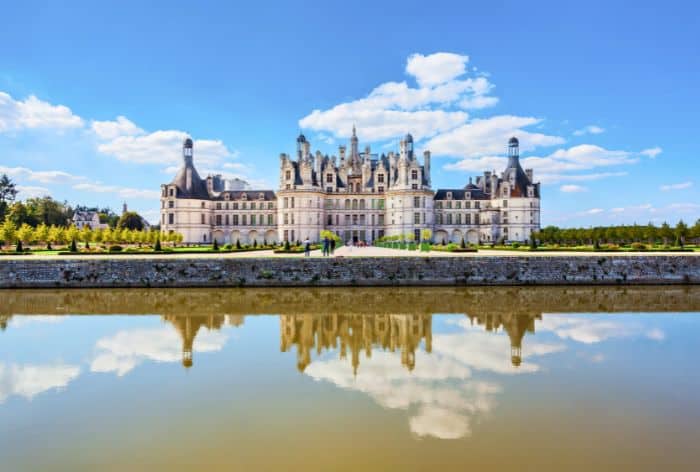
Château de Chambord / What to See at Château de Chambord
Despite its immense grandeur, Chambord was never intended to be a permanent residence. François I only spent 72 days here, using it mainly for hunting trips and lavish royal gatherings.
Later, Louis XIV gave the château a makeover, turning it into a lavish symbol of his power and style. He even hosted the premiere of a Molière play in its grand halls, making Chambord an important cultural site as well.
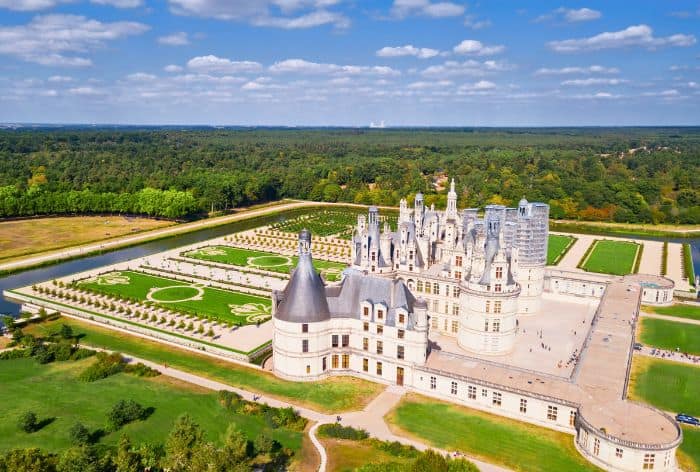
Château de Chambord / What to See at Château de Chambord
Fast forward to World War II, and Chambord played a crucial role in safeguarding some of the world’s most priceless works of art. The château became a secret refuge for masterpieces like the Mona Lisa, keeping them safe from Nazi looters.
Today, as a UNESCO World Heritage Site, Chambord is an absolute must-see. Its towering spires, intricate carvings, and sprawling grounds make you feel as though you’ve stepped into a fairy tale. With every turn, you’ll uncover more stories about the royal life that once graced these walls.
What to See at Château de Chambord
The Architecture of Château de Chambord
Château de Chambord is a masterpiece of Renaissance architecture, designed to impress rather than defend.
At first glance, its massive towers and moat give it the look of a medieval fortress, but these features were purely decorative, symbolizing power rather than serving any military purpose.
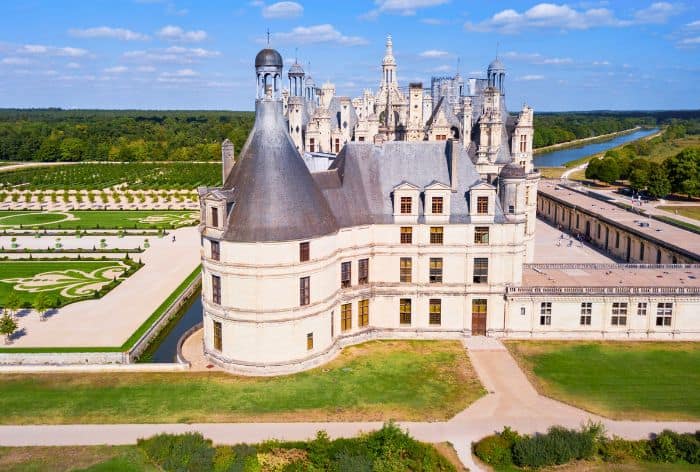
Château de Chambord / What to See at Château de Chambord
At the heart of the château is the keep, a square structure with four imposing corner towers. Its layout follows a Greek cross design, an unusual choice for a royal residence but one that reinforced King François I’s vision of Chambord as a grand statement of his reign.
Inside, the keep is symmetrically arranged with four identical living spaces on each level, connected by wide galleries and staircases. Two wings stand out—the royal wing, where François I would have stayed during his visits, and the chapel wing, which was never fully completed.
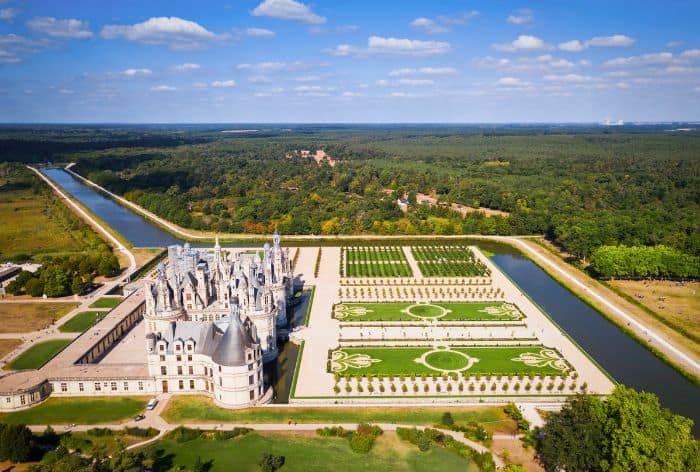
Château de Chambord / What to See at Château de Chambord
One of the biggest mysteries of Chambord is its architect. While no official records exist, many believe Leonardo da Vinci had a hand in its design. The château’s perfect symmetry, innovative layout, and engineering feats, such as its advanced waterproofing system for the terraces, all suggest his influence.
The façades reflect Renaissance ideals of balance and proportion, while the upper levels feature intricate carvings, blending French and Italian architectural styles in a way that was groundbreaking for the time.
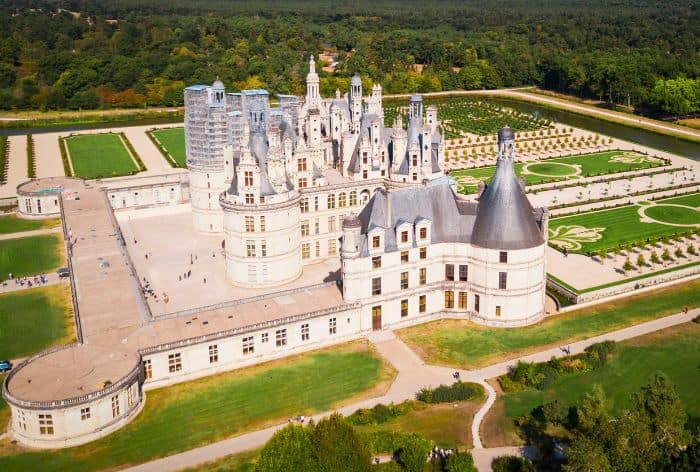
Château de Chambord / What to See at Château de Chambord
Every detail of Chambord was designed with artistic ambition in mind. From its soaring rooftops adorned with over 280 chimneys to its richly sculpted stonework, the château remains one of the most extraordinary architectural achievements of the Renaissance.
The Famous Double-Helix Staircase
The heart of Château de Chambord is its legendary double-helix staircase—a masterpiece of engineering and design.
This stunning spiral staircase consists of two intertwined ramps winding independently around a central column. Two people can use the staircase at the same time—one going up, the other going down—without ever crossing paths.

Double-Helix Staircase / What to See at Château de Chambord
The staircase is designed to draw in natural light, thanks to large windows that illuminate the stonework as you ascend. It also connects the château’s main floors, making it the focal point of the entire structure.
I bet you will find yourself mesmerized by its optical illusion-like effect, trying to figure out how the two ramps twist together—or even testing it out by walking on different spirals and catching glimpses of each other through openings in the central column.
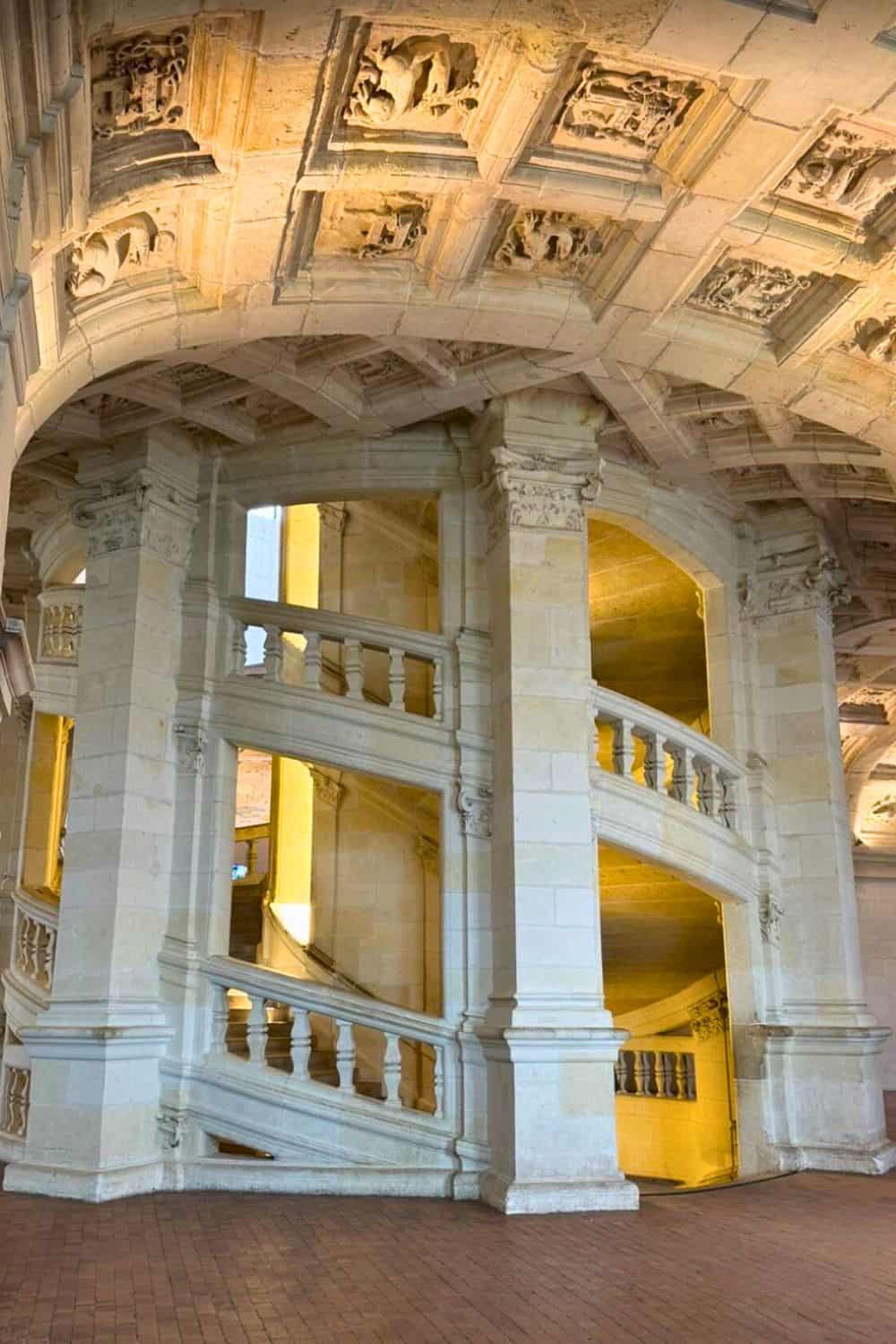
Double-Helix Staircase / What to See at Château de Chambord
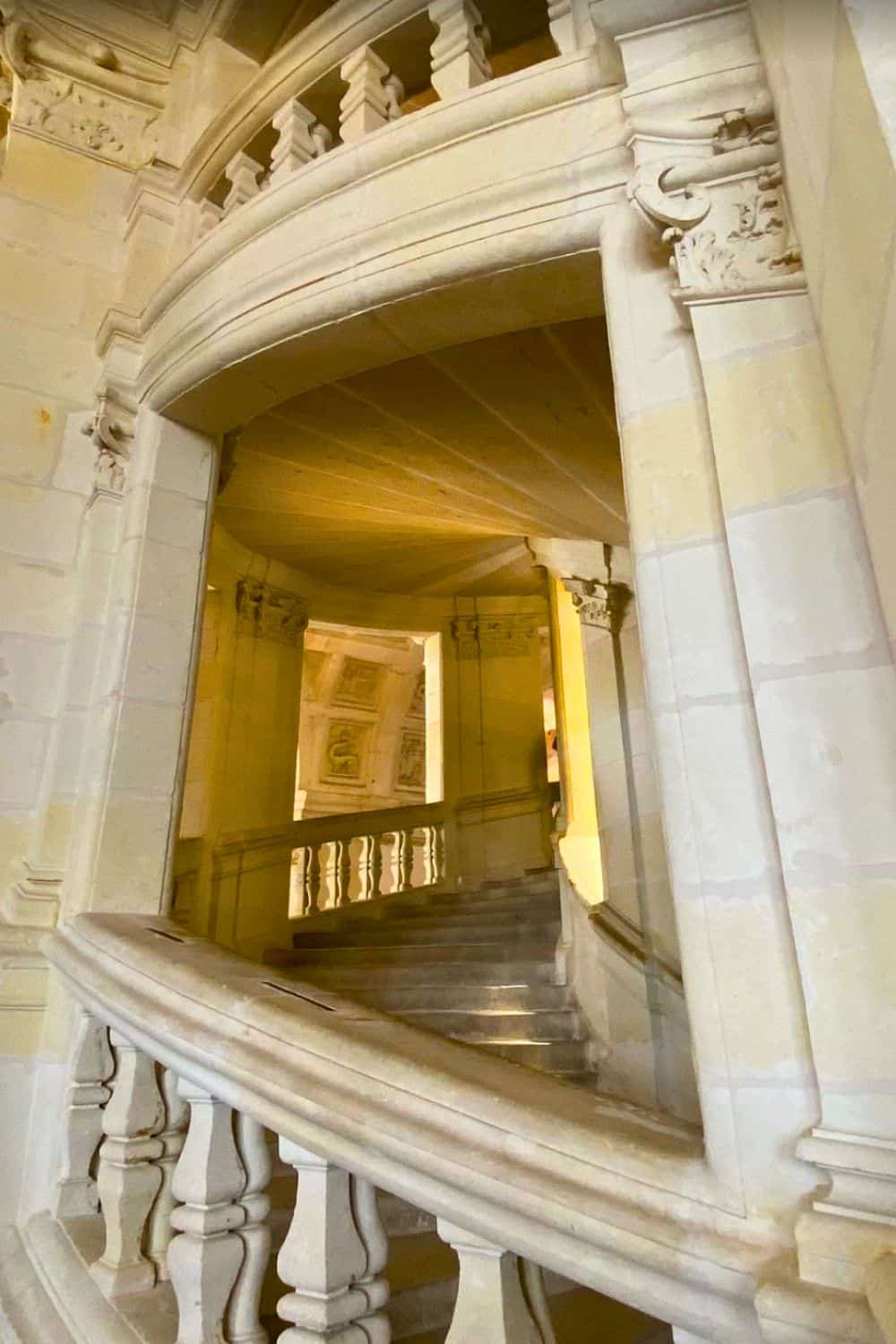
Double-Helix Staircase / What to See at Château de Chambord
Though its exact origins remain a mystery, many believe that Leonardo da Vinci played a role in its design. Da Vinci was working in France under the patronage of King François I and was fascinated by double-helix structures, which are now recognized as the shape of DNA. Whether or not he was directly responsible, the staircase is a perfect example of the Renaissance blending art, science, and innovation.
The Roof Terrace and Chimneys of Château de Chambord
One of the most iconic features of Château de Chambord is its stunning roof terrace, which offers some of the best panoramic views of the château and the surrounding countryside.
Accessible via the famous double helix staircase, this area is a true architectural marvel, designed not just for function but for beauty. The terraces are adorned with decorative elements that make them stand out, including intricate roof lanterns and numerous chimneys.
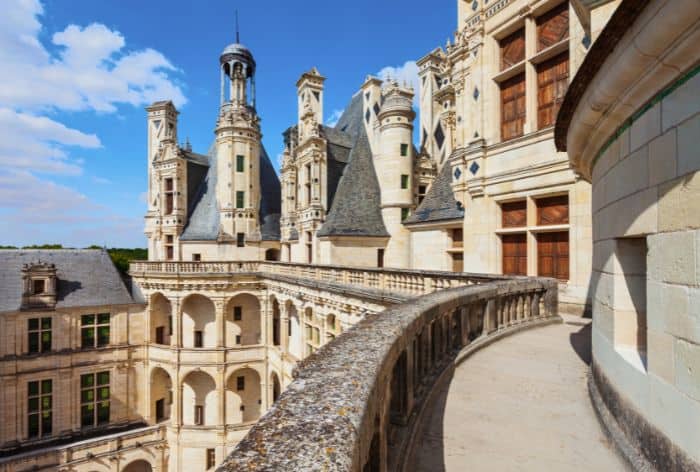
The Roof Terrace and Chimneys / What to See at Château de Chambord

The Roof Terrace and Chimneys / What to See at Château de Chambord
The roof lanterns are particularly impressive. Crowned with lead fleur-de-lis, these six towering structures were restored to their original splendor in 2023, adding both charm and structural integrity to the roofline. They are a defining feature of the château’s silhouette, and their historical restoration highlights the château’s commitment to preserving its grandeur.
As you look up, you’ll also notice the chimneys, which are scattered across the roof. While it’s often said that there are 365 chimneys—one for each day of the year—the actual number is 282.
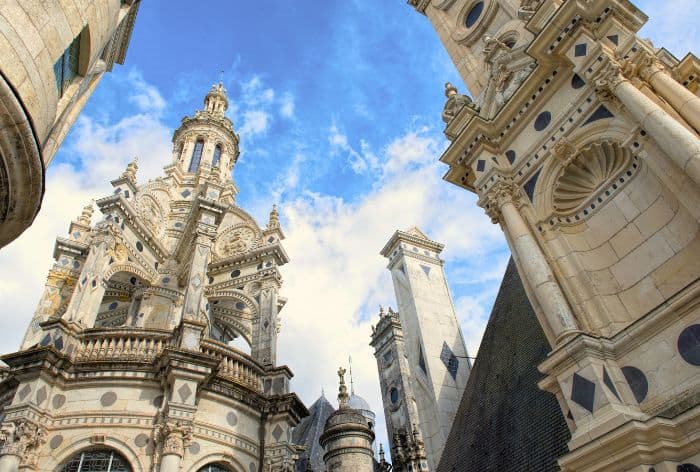
The Roof Terrace and Chimneys / What to See at Château de Chambord
Each chimney is uniquely designed, and they’re not just practical for the château’s heating systems but also serve as an aesthetic element, contributing to the ornate and intricate appearance of the roof.
The roof’s design was inspired by François I’s admiration for the skyline of Constantinople, which influenced the château’s Renaissance architecture. This is reflected in the many sculpted columns, pinnacles, and other decorative details that give the roof its signature look.
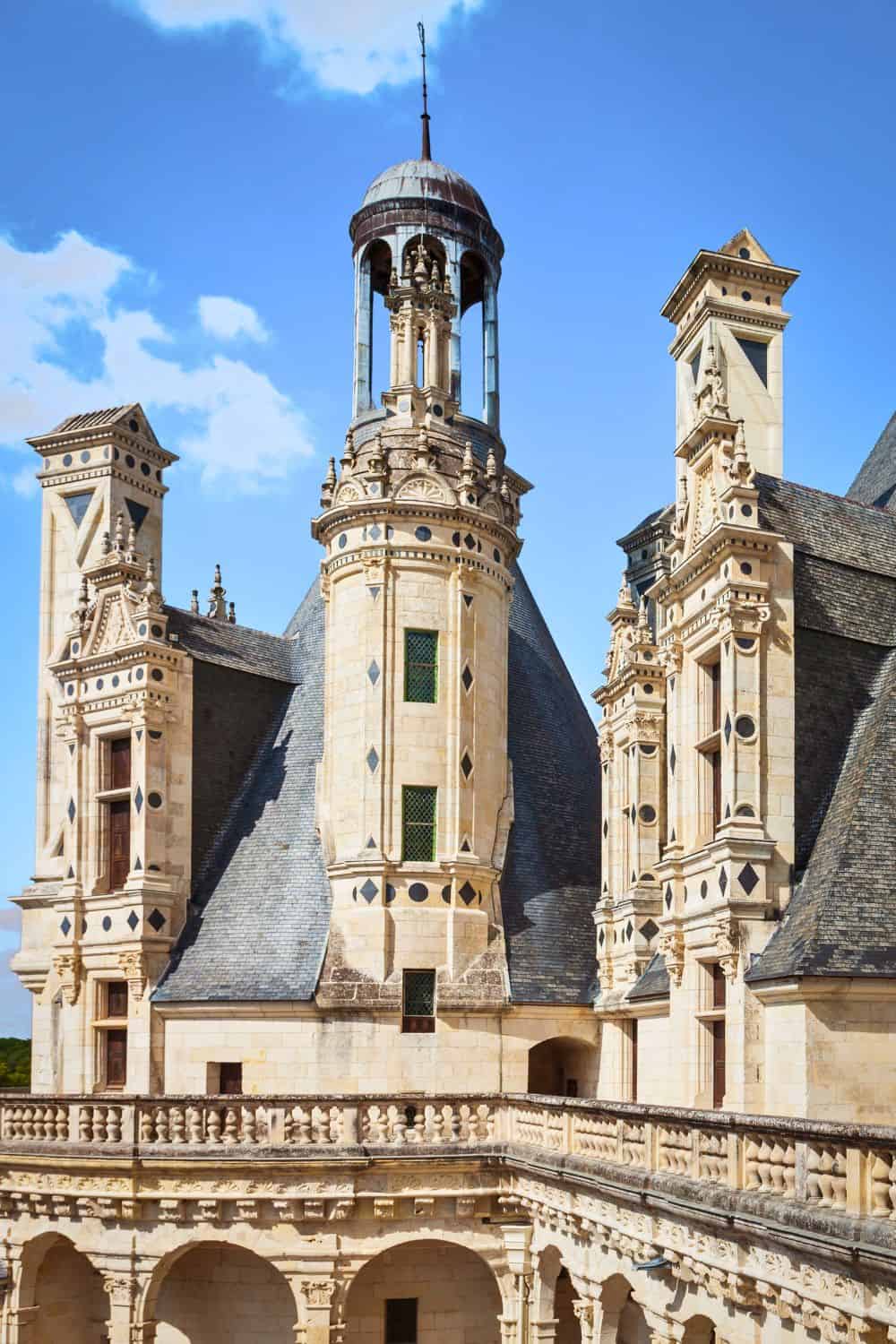
The Roof Terrace and Chimneys / What to See at Château de Chambord
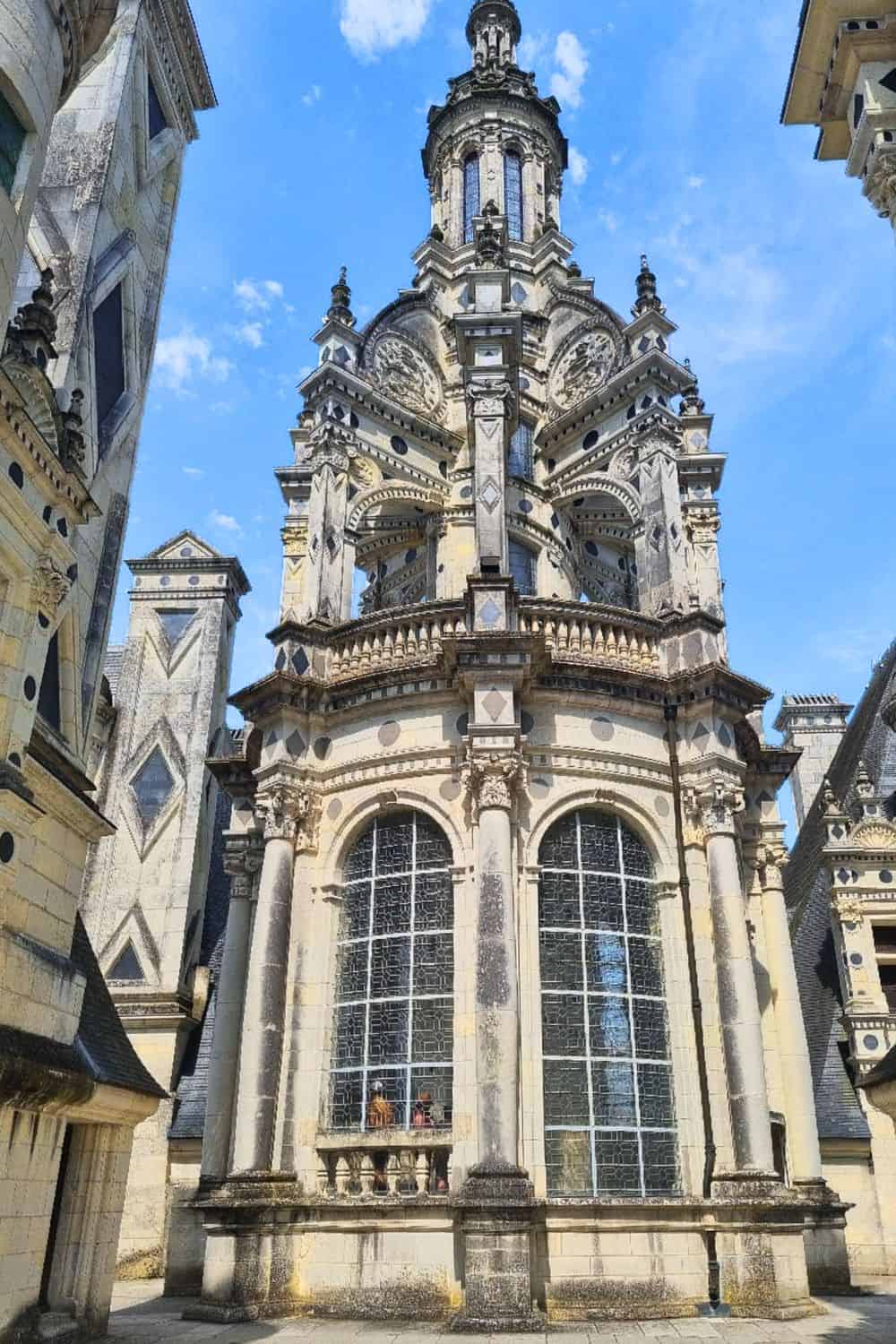
The Roof Terrace and Chimneys / What to See at Château de Chambord
The Coach Room (Salle des Carrosses) - Ground Floor
The Coach Room on the ground floor of the Royal Wing at Château de Chambord is one of those spots that’s easy to miss, but it’s definitely worth a look.
In here, you’ll find some truly impressive horse-drawn carriages, built specifically for the Comte de Chambord. These aren’t just any carriages—they were made by Binder, with beautiful saddlery crafted by none other than Hermès. However, the interesting twist is that these carriages were never actually used.
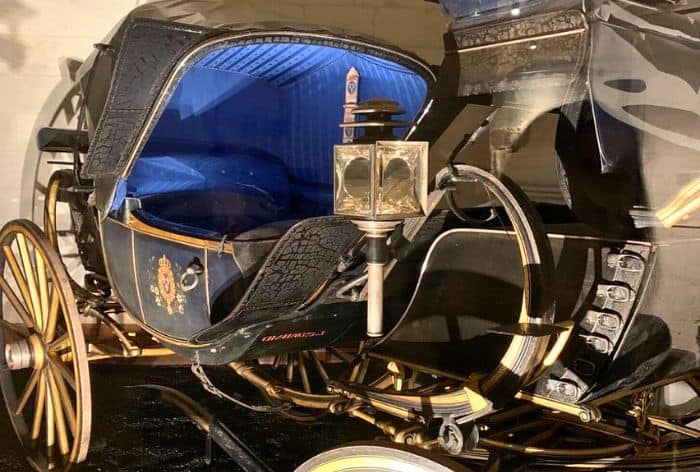
The Coach Room / What to See at Château de Chambord
Why? Well, in 1871, the French crown was offered to the Comte, but he turned it down. So, despite the grandeur of these carriages, they stayed idle, gathering dust. It’s a little sad to think about, really—a royal opportunity that never came to be, and these elegant carriages standing as a reminder of what might have been.
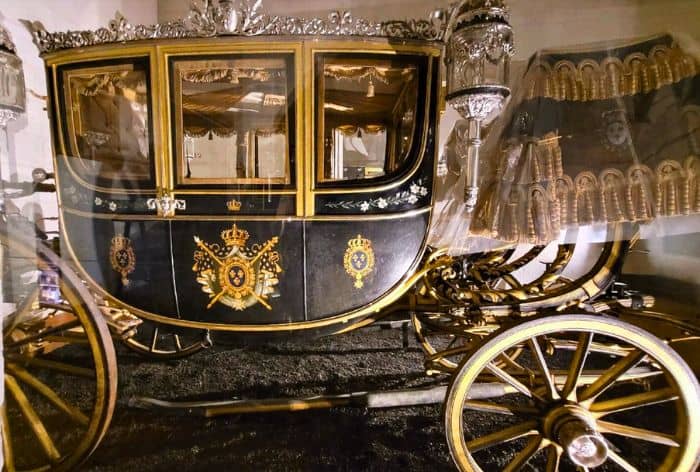
The Coach Room / What to See at Château de Chambord
Walking through this room feels like stepping back in time, almost like you’re peeking into a royal dream that was never fully realized. The craftsmanship of the carriages is stunning, and it’s hard not to imagine how different things might have been if the Comte had accepted the crown. The whole setup adds a layer of mystery and history to Chambord, making it even more fascinating.
The State Apartment (Appartement de Parade) - First Floor
The Appartement de Parade (State Apartment) on the first floor of Château de Chambord was created for King Louis XIV between 1680 and 1682.
It’s an impressive suite made up of nine rooms, each designed with a specific function, all in line with the strict rules of royal court life at the time:
- Salle des Gardes (Guard Room): This room was used by the king’s guards to ensure security and manage who could enter the more private areas of the apartment.
- Première Antichambre (First Antechamber): This was a transitional space leading to storage rooms, where tapestries and furniture were kept.
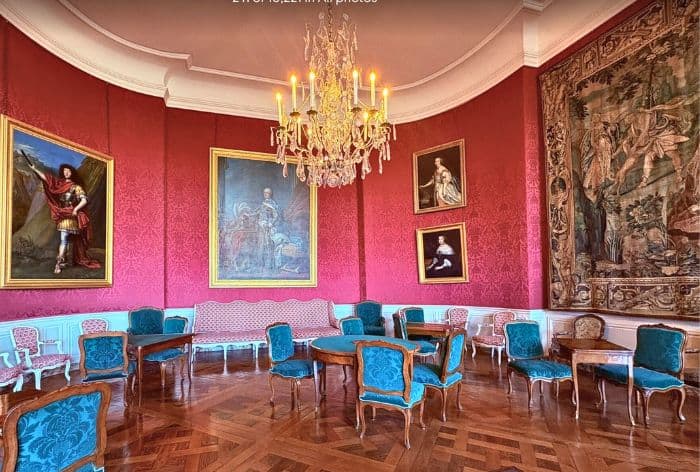
The State Apartment / What to See at Château de Chambord
- Deuxième Antichambre (Second Antechamber): This room connected the first antechamber to the king’s main bedroom, keeping the flow of the court’s formal hierarchy in check.
- Chambre de Parade (Official Bedchamber): This is the most important room, with a grand bed that had a canopy. It’s where the king held daily ceremonies, like the “lever” (his rising) and “coucher” (his retiring for the night), which were important public rituals at court.
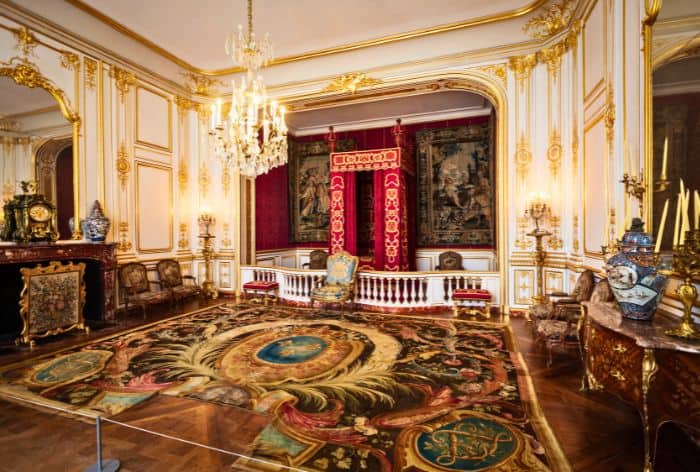
The State Apartment / What to See at Château de Chambord
- Trois Cabinets Privés (Three Private Cabinets): These were smaller, private spaces used for meetings, study, or to store personal items.
As for the furnishings, the rooms were outfitted with everything from canopied beds to writing tables, and portraits of key figures like Louis XIV and Madame de Maintenon. However, the furniture wasn’t permanent. Before the king arrived, officers would come in and set everything up, making sure the rooms were ready for the royal visit.
In the 18th century, the Count of Saxony, a Marshal of France, made some notable changes to the apartment to add comfort and luxury. He lowered the ceilings, remodeled the fireplace with a beautiful marble mantel, put in new parquet floors, and added gorgeous wood paneling. He even created a special alcove for the king’s bed, enclosed by a balustrade. The Count actually passed away in this room in 1750.
Today, the Appartement de Parade is displayed as it was during the Count of Saxony’s time, with the 18th-century wood paneling and a recreated royal bed based on early 18th-century designs.
François I’s Private Quarters and Oratory - First Floor
Tucked away in the eastern tower of the château, you will find François I’s private quarters.
Unlike the grand, ceremonial rooms used for official business, these private rooms were designed for comfort, offering the king a bit of privacy in his otherwise public life:
- A bedroom – his main living space, where he slept and relaxed.
- A wardrobe (garde-robe) – not just for clothing, but also for storage.
- A study (cabinet) – a small room for reading, writing, and private meetings.
- A personal chapel (oratory) – a tiny, beautifully decorated space for prayer.
Unlike the grand halls of the château, these rooms were designed to feel warmer and more livable. Chambord could be cold and damp, so the king’s quarters were lined with rush mats, rich tapestries, and elegant furniture to make things cozier. His final stay in these rooms was from February 22 to March 14, 1545, not long before he passed away.
One of the most unique features of François I’s private quarters is his oratory (private chapel), built around 1540. This little sanctuary is tucked between the tower’s outer wall and an interior gallery, allowing the king to pray in peace.
The ceiling is designed in the style of Italian Renaissance churches, and the walls are covered with intricate carvings of François I’s emblem—the salamander—along with fleurs-de-lis and his royal monogram.
In the 17th century, the private quarters of François I, including his oratory (private chapel), were used by Maria Theresa of Spain, the first wife of Louis XIV. While François I originally designed these rooms for his personal comfort, they later served as the queen’s private retreat when she stayed at Chambord.
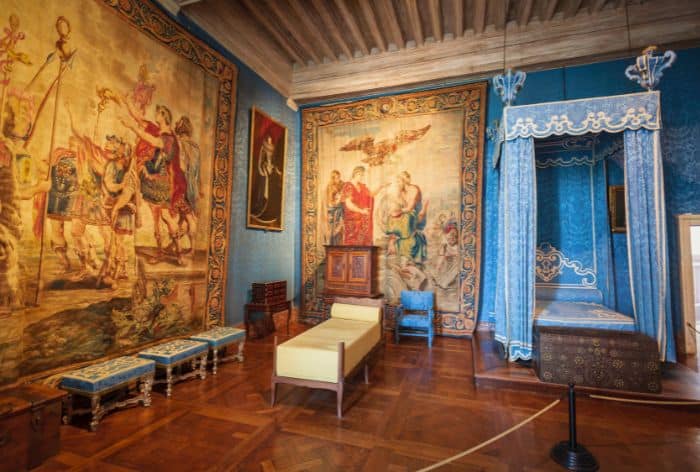
François I’s Private Quarters / What to See at Château de Chambord
Maria Theresa used the oratory as her own chapel, just as François I had. Though she lived in an era dominated by the grandeur of Versailles, her time at Chambord would have offered a quieter, more secluded atmosphere compared to the strict court life at the Sun King’s palace.
The Chapel (Sainte-Chapelle de Chambord) - First Floor
Also, on the first floor in the northwest wing, you will find the Chapel (Sainte-Chapelle de Chambord).
It was built in the early 16th century and served as the main place of worship for the king and his court during their stays at Chambord.
The chapel stands out with its soaring ceilings, Gothic-style windows, and intricate stone carvings. Though Chambord is mainly a Renaissance masterpiece, the chapel retains elements of Gothic architecture, a reminder of the older medieval influences still present during François I’s reign.
Inside, the space is bright and open, with large windows that allow natural light to pour in.
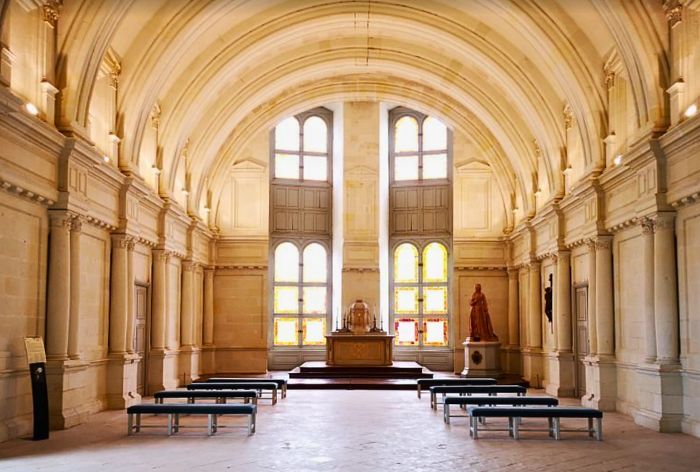
The Chapel / What to See at Château de Chambord
The chapel was used for private royal services, where the king and his entourage could attend Mass without leaving the château. Over time, it also hosted religious ceremonies for other members of the royal family.
Though it may not be as lavishly decorated as some other royal chapels in France, its simplicity and elegance make it a peaceful retreat within the grand halls of Chambord.
Vaulted Rooms with Ornate Ceilings - Second Floor
When you step onto the second floor of Château de Chambord, look up—you’ll see some of the most stunning ceilings in the entire castle. The rooms here are laid out in a cross shape, but it’s the vaulted ceilings that steal the show. They’re covered in intricate carvings, each one packed with meaning.

Vaulted Rooms / What to See at Château de Chambord
You’ll notice salamanders, the personal emblem of King François I, often shown surrounded by flames, symbolizing his endurance and power.
Then there are the crowned ‘F’ monograms, a not-so-subtle reminder of whose château you’re standing in. And if you spot an elaborate knotted rope motif, that’s a nod to François I’s mother, Louise of Savoy.
These symbols weren’t just for decoration—they were the king’s way of making his mark on Chambord, ensuring that every visitor (even centuries later) knows exactly whose castle this was.
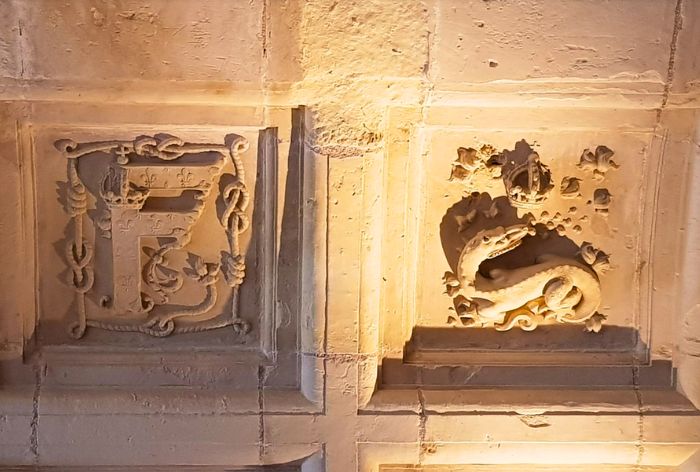
King François Emblems / What to See at Château de Chambord
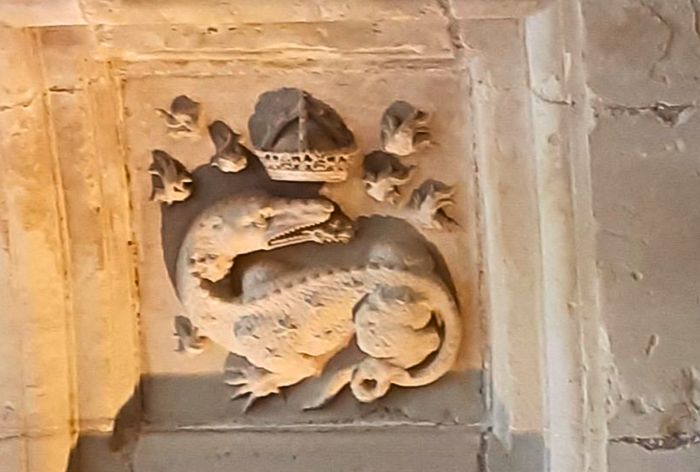
King François Emblems / What to See at Château de Chambord
Beyond their beauty, the vaults also demonstrate innovative engineering. The stone coffers in the ceiling reduce weight without compromising strength, an advanced technique for the time. This design helps distribute the load of the upper terraces, which feature some of Chambord’s most spectacular views.
Beyond the ceilings, the second floor also showcases displays dedicated to Chambord’s deep connection with hunting, one of the favorite pastimes of French royalty. You’ll find hunting trophies, antique firearms, detailed paintings, and rich tapestries depicting royal hunts. Since François I originally built Chambord as a hunting retreat, it makes sense that these exhibits celebrate that history, giving you a glimpse into the lavish hunting traditions of the time.
Maréchal de Saxe Theater - Second Floor
One of the standout rooms on the second floor is the Maréchal de Saxe Theater, a unique reminder of how Chambord evolved over the centuries.
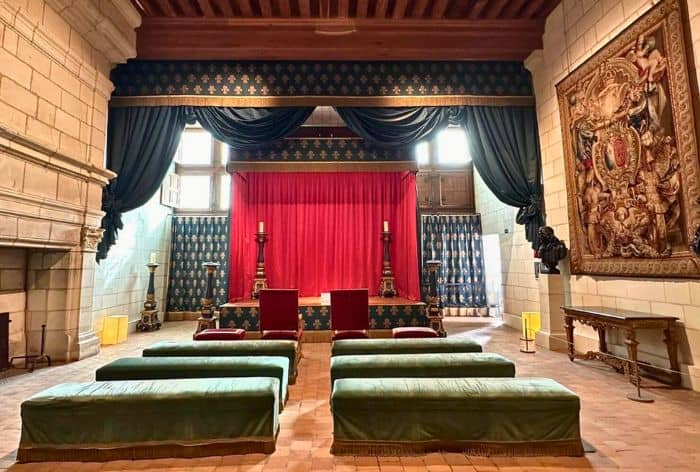
Maréchal de Saxe Theater / What to See at Chateau de Chambord
Originally designed as part of the château’s grand living spaces, this room was transformed into a theater during the time of Maurice de Saxe, a Marshal of France and a brilliant military leader.
In the mid-18th century, he used Chambord as his residence, and the theater was created to host performances for the court and distinguished guests.
Exhibition on World War II Art Preservation - Second Floor
The second floor of Château de Chambord also features a fascinating exhibition called “Chambord, 1939-1945: Saving Some of the World’s Beauty.”
This exhibit reveals a lesser-known but incredibly important chapter in the château’s history. During World War II, Chambord became a safe haven for priceless works of art.
As the Nazis advanced through France, the château played a crucial role in protecting masterpieces from French museums, ensuring that cultural treasures like paintings, sculptures, and other invaluable artifacts were kept safe from destruction.
The Gardens of Chambord
After wrapping up your tour of the château, head to the gardens.
- The French Gardens
Designed by Louis XIV, the layout was finished in 1734, and it spans a huge 6.5 hectares right at the base of the château.
From the terraces, you can spot the impressive 4.5 km-long axis cutting through the gardens, shaped like an arrow. Fun fact – this axis actually points directly to the famous double-revolution staircase inside the château!
While these gardens were once grand and full of life, they fell into disuse over the years and were turned into simple grassy plots by 1970. But in 2015, a big restoration project kicked off to bring them back to their former splendor. After 16 years of research and studies on the original landscape, the château is now home to beautifully restored gardens.
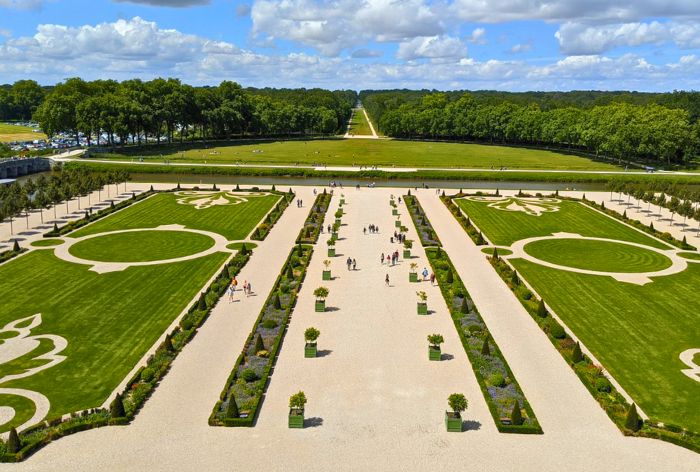
The French Gardens / What to See at Chateau de Chambord
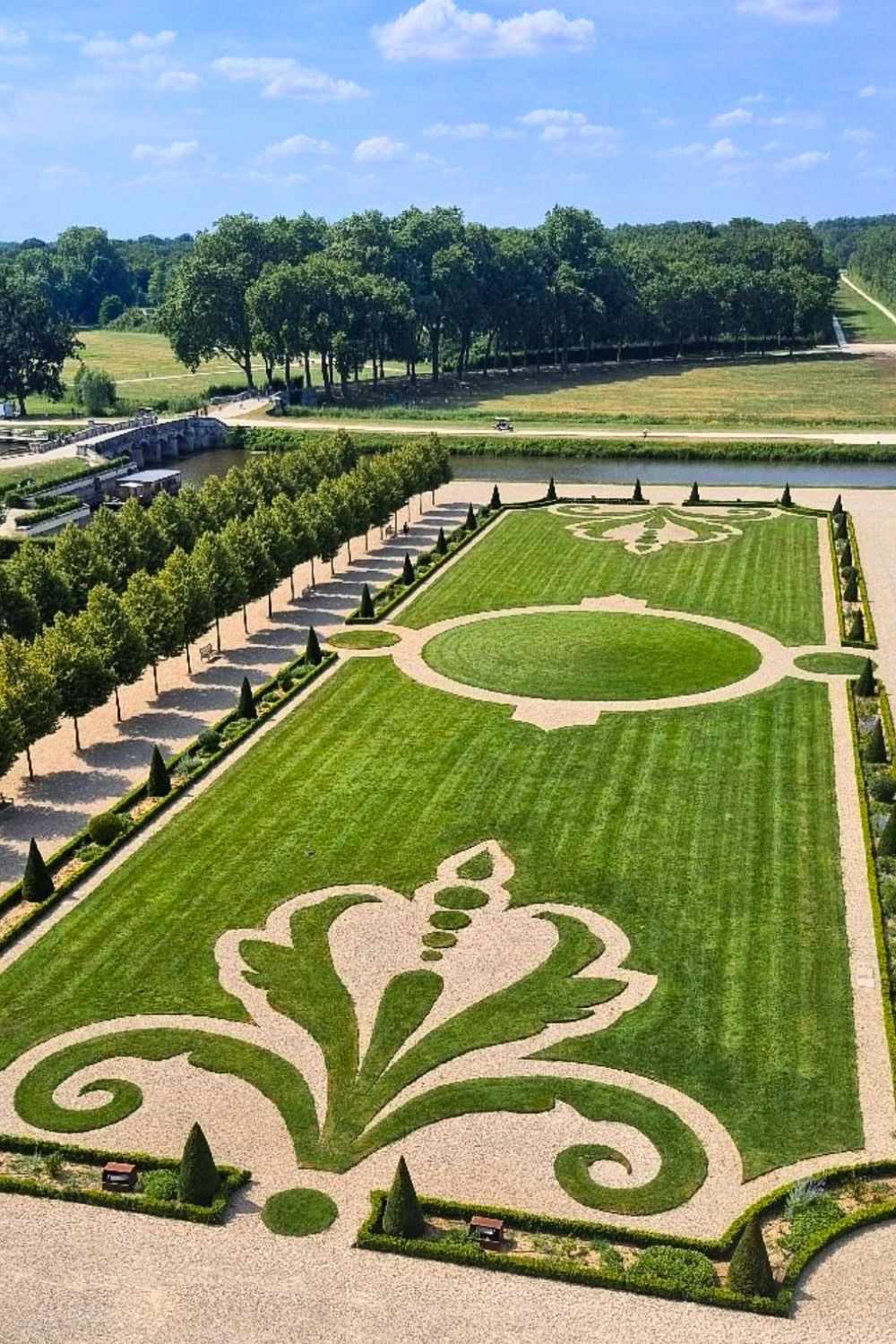
The French Gardens / What to See at Chateau de Chambord
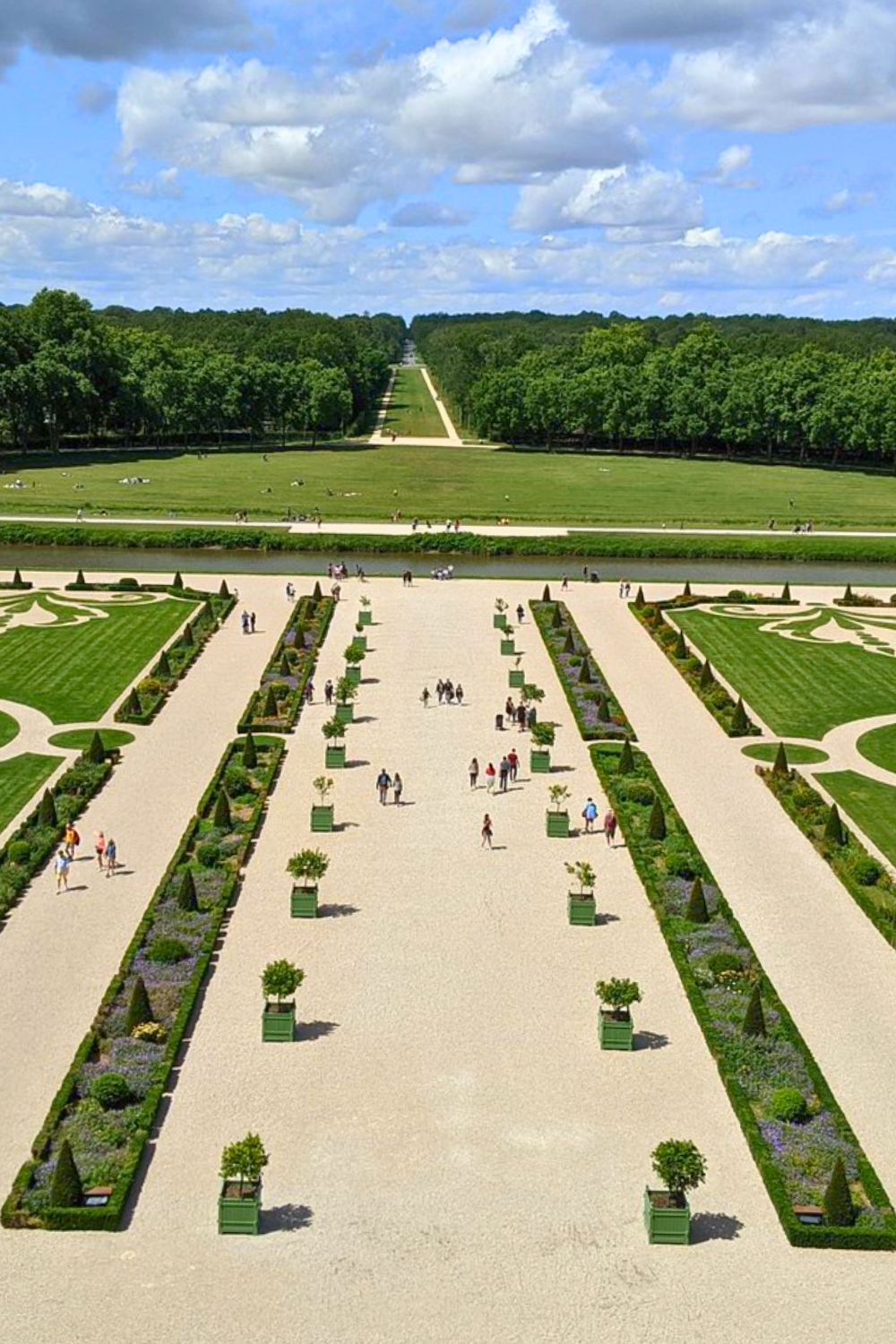
The French Gardens / What to See at Chateau de Chambord
- The English Garden
After seeing the more structured and symmetrical French gardens, you will be surprised by the English garden, which feels much more relaxed. It’s filled with free-form groves, tall isolated trees, and meadows.
The 80 species of plants here follow the style of English gardens from the late 18th and early 19th centuries. Originally imagined in 1880, the garden was thoughtfully recreated in 2014 to offer a more tranquil experience than its French counterpart.
- The Stables,
Make sure to check out the stables, which were originally planned by Louis XIV. Today, it’s home to the horses used in equestrian shows.
Practical Tips for Visiting Château de Chambord
Getting to Château de Chambord and Parking
Château de Chambord is about 170 km (105 miles) south of Paris, near Blois. If you’re planning to explore multiple Loire Valley châteaux, having a car is the easiest way to get around.
- By Car
Driving is the most flexible option, and Chambord is less than a two-hour drive from Paris. Take the A10 motorway towards Tours, then exit at Mer (Exit 16) or Blois (Exit 17) and follow signs for Chambord.
- By Train
The nearest station is Blois-Chambord, about 15 km from the château. From Paris, take a train from Gare d’Austerlitz (about 1 hour 20 minutes). From Blois, you can take a shuttle bus directly to the château to grab a taxi for a quick ride.
Parking at Château de Chambord is available for a fee. The main parking lot is located near the château entrance. As of the latest information, the parking fee is €6 per vehicle.
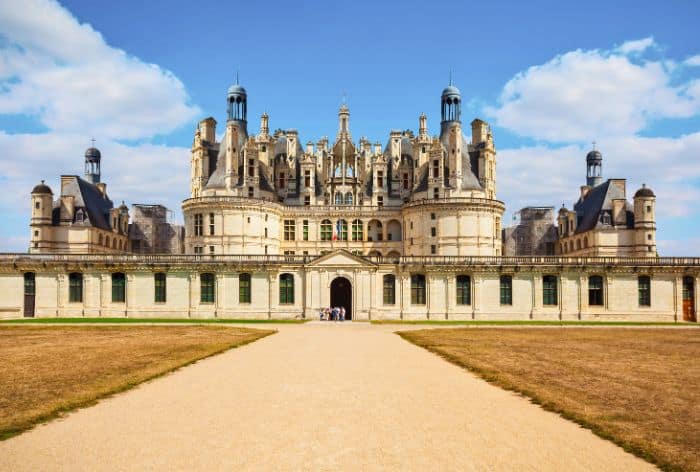
Château de Chambord / What to See at Château de Chambord
Tickets and Opening Times
Château de Chambord is open all year, but hours change with the seasons. From April to October, you can visit between 9:00 AM and 6:00 PM, while from November to March, it closes an hour earlier at 5:00 PM.
Tickets cost €14.50 for adults to explore the château and park, or €19.50 if you want to include temporary exhibitions. If you’re under 18, admission is free. Students and young adults (18-25) get a discounted rate of €9.50.
PRO TIP: Save time by buying your tickets online in advance. This way, you can skip the ticket line and head straight into the château. It’s especially useful during peak season when crowds are bigger!
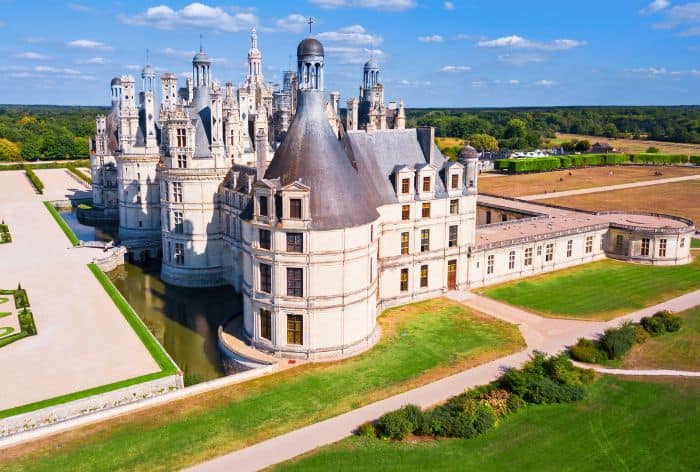
Château de Chambord / What to See at Château de Chambord
Where to Eat at Château de Chambord (and Nearby)
Exploring Château de Chambord is an adventure, and at some point, you’re going to need to refuel. Whether you want a quick snack or a full-on French dining experience, there are some great options both inside the château grounds and just outside in the village.
GOOD TO KNOW: Heads up—many restaurants nearby close on Mondays, so if you’re visiting then, grabbing a meal at the château itself is the easiest choice.
- Eating at the Château
Autour du Puits – If you’re in the mood for something simple but satisfying, this little spot near the château is a great pick. They serve sandwiches, pastries, and other light bites—perfect if you don’t want to spend too much time sitting down for a meal.
Café d’Orléans – Want something a bit more filling? Café d’Orléans offers classic French dishes. It’s a solid option if you want to sit down and enjoy your food.
- Restaurants Near the Château
Le Saint-Louis – If you’re craving a traditional French brasserie experience, this is the place. Located in the village square near the château, Le Saint-Louis serves classic French dishes. It’s a great spot to sit back and enjoy a leisurely meal.
La Cave des Rois – Wine lovers, this one’s for you! La Cave des Rois is all about fresh, high-quality ingredients paired with a fantastic selection of wines.
How Much Time Is Needed to Visit Château de Chambord
Visiting the Château de Chambord is a remarkable experience, even if you have only half a day. While a full day allows for a more comprehensive exploration, a well-planned half-day visit can still cover the highlights.
Here’s a suggested itinerary to make the most of your time:
Morning Visit (3.5 hours total):
- 9:00 AM – Arrival and Exterior Exploration (1 hour): Begin with a walk around the château’s exterior to appreciate its grand facades and distinctive French Renaissance architecture.
- 10:00 AM – Interior Tour (1.5 hours): Enter the château and explore key areas, including: The famous double helix staircase, the royal apartments and the panoramic terraces offering views of the estate.
PRO TIP: Consider using the HistoPad, an interactive tablet that provides a virtual tour of the château as it was in the 16th century, enhancing your understanding of its history and architecture.
- 11:30 AM – Formal Gardens (45 minutes): Stroll through the meticulously restored French formal gardens, taking in the symmetrical designs and vibrant flowerbeds.
- 12:15 PM – Departure: Conclude your visit and proceed to your next destination or enjoy lunch at a nearby restaurant.
GOOD TO KNOW: The château tends to be busiest between 12:00 PM and 5:00 PM, with peak times from 2:00 PM to 4:00 PM. Arriving at opening time helps avoid crowds.
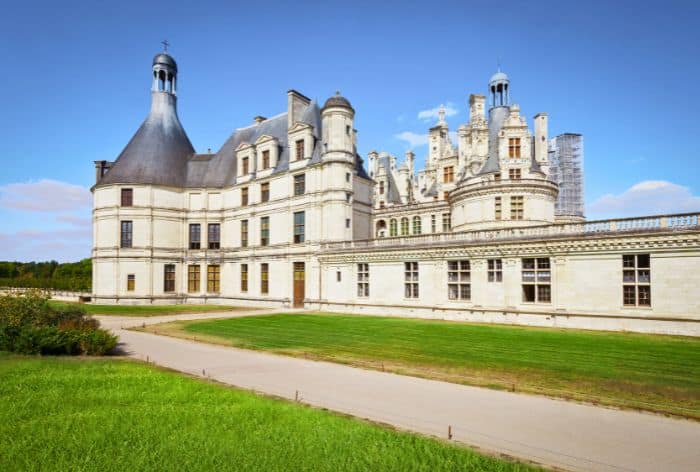
Château de Chambord / What to See at Château de Chambord
Here Are Some More Ideas of Places to Visit in France:
Did You Find It Useful? Why Not Save What to See at Château de Chambord to Pinterest!


Now, It Is Your Turn, I Would Like to Hear Back from You!
Are you planning your trip to France?
Please let me know! Drop me a quick comment right below!
Click on any of the images below to get inspired and to help you with the planning process for your trip to France!
